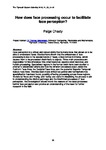How does face processing occur to facilitate face perception?
| dc.contributor.author | Chasty, P. | |
| dc.date.accessioned | 2019-05-22T08:53:23Z | |
| dc.date.available | 2019-05-22T08:53:23Z | |
| dc.date.issued | 2018 | |
| dc.identifier.citation |
Chasty, P. (2018) 'How does face processing occur to facilitate face perception?', The Plymouth Student Scientist, 11(2), p. 34-52. | en_US |
| dc.identifier.issn | 1754-2383 | |
| dc.identifier.uri | http://hdl.handle.net/10026.1/14183 | |
| dc.description.abstract |
Face perception is a critical and valued ability that humans have that allows us to be able to understand faces. Studies have shown that the uniqueness of face processing is due to the special nature of faces, a bias formed in infancy, which causes them to be processed dissimilarly to objects. Three main processes are responsible for this difference: first-order relational, second-order relational, and holistic processing. Specialised regions in the human brain have been studied to attempt to understand where and how the different processes occur, called the Fusiform Face Area, the Occipital Face Area, and the posterior Superior Temporal Sulcus Face Area. This has been made difficult as gender and hemisphere role specialisation has been found, possibly affecting processing across these regions. Models by Bruce and Young, and Haxby, are useful in visualising the process to aid in understanding the distinct pathways and the interlinked processes of face perception. The investigation should inform the readers on the basic processes behind face perception and provide an understanding of the need for further research in the field. | en_US |
| dc.language.iso | en | en_US |
| dc.publisher | University of Plymouth | |
| dc.rights | Attribution 3.0 United States | * |
| dc.rights.uri | http://creativecommons.org/licenses/by/3.0/us/ | * |
| dc.subject | face perception | en_US |
| dc.subject | human face | en_US |
| dc.subject | face processing | en_US |
| dc.subject | human brain | en_US |
| dc.subject | Fusiform Face Area | en_US |
| dc.subject | Occipital Face Area | en_US |
| dc.title | How does face processing occur to facilitate face perception? | en_US |
| dc.type | Article | |
| plymouth.issue | 2 | |
| plymouth.volume | 11 | |
| plymouth.journal | The Plymouth Student Scientist |



